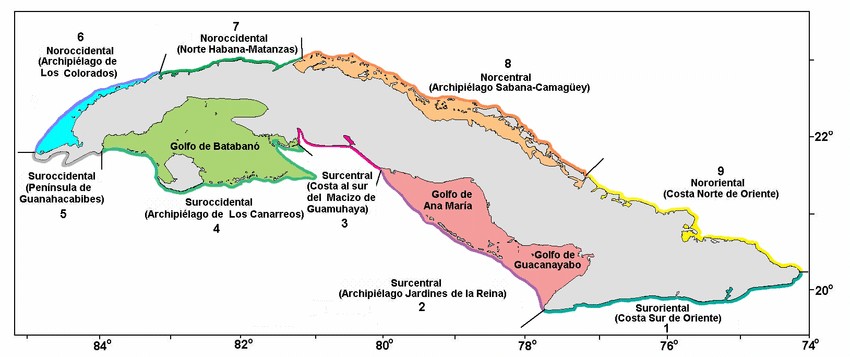Influence of the wind on the arrival of sargasse to the coast of Cuba
Main Article Content
Abstract
The winds play an important role in the arrival of sargassum to the Cuban coasts, since these marine macroalgae, lacking their own swimming, depend on the oceanic and atmospheric circulation for their movement. For this reason, the objective is to analyze the direction and speed of the wind on the coasts of Cuba, highlighting the winds that could have favored the arrival of sargassum. In this research, wind data from Cuban coastal stations were used. It was shown that the winds that most frequently influenced the northern coast, both in the rainy period and in the dry period, are those of the first quadrant, with the winds from the north, north-northeast and east being the most representative, which They allowed the arrival of sargassum towards Matanzas, Havana, Villa Clara and Guantánamo. On the south coast, in the rainy and dry periods, the most influential winds were those from the second quadrant, with the winds from the south-southeast, southeast and south being the most predominant, which favored the arrival of sargassum towards Matanzas, Cienfuegos, Ciego de Ávila, Camagüey, Santiago de Cuba and Granma, as well as in the special municipality of Isla de la Juventud. Furthermore, it was shown that, in the western and central region of the archipelago, both on the north coast and on the south coast, the winds were weak, less than 16 km/h, while on the rest of the coasts they were between 17 and 20 km/h.
Downloads
Article Details

This work is licensed under a Creative Commons Attribution-NonCommercial 4.0 International License.
Those authors who have publications with this journal accept the following terms of the License Attribution-NonCommercial 4.0 International (CC BY-NC 4.0):
You are free to:
- Share — copy and redistribute the material in any medium or format
- Adapt — remix, transform, and build upon the material
The licensor cannot revoke these freedoms as long as you follow the license terms.
Under the following terms:
- Attribution — You must give appropriate credit, provide a link to the license, and indicate if changes were made. You may do so in any reasonable manner, but not in any way that suggests the licensor endorses you or your use.
- NonCommercial — You may not use the material for commercial purposes.
- No additional restrictions — You may not apply legal terms or technological measures that legally restrict others from doing anything the license permits.
The journal is not responsible for the opinions and concepts expressed in the works, they are the sole responsibility of the authors. The Editor, with the assistance of the Editorial Committee, reserves the right to suggest or request advisable or necessary modifications. They are accepted to publish original scientific papers, research results of interest that have not been published or sent to another journal for the same purpose.
The mention of trademarks of equipment, instruments or specific materials is for identification purposes, and there is no promotional commitment in relation to them, neither by the authors nor by the publisher.
References
Aguilar-Rosas L, Aguilar-Rosas R, Lora-Sánchez D (2003) Record Size for Gelidium Robustum (Gardner) Hollenberg Et Abbott (Gelidiales, Rhodophyta) in the Pacific Coast of México. Oceánides 18, 83-85
Aguilera-Méndez J, Juárez-Toledo C, Tapia-Fabela J, et al. (2023). Modelación Numérica de la Trayectoria del Sargazo Pelágico Utilizando Ecuaciones Brownianas con Aplicación a las Aguas de la Península de Yucatán, México. Ingeniería Del Agua 27, 45–58.
González, P., 1995. Caracterización de las especies de Sargassum de Playa Gibara, Cuba. Tesis de Diploma, Universidad de Oriente, 80 pp.
Hernández-Lara J.A. (2023). Dinámica del transporte de sargazo pelágico en el Caribe mexicano. Universidad Nacional Autónoma de México. Thesis · September 2023. DOI: 10.13140/RG.2.2.30002.99526.
Hill B (2016) An Analysis of the Factors That Influence the Sargassum Migratory Loop. Texas A&M University. Tesis De Maestría, 30 Pp
Moreira, L. Cabrera, R., Suarez, A.M., 2006. Evaluación de la biomasa de macroalgas marinas del género Sargassum C. Agardh. (Phaeophyta, Fucales). Rev. Invest. Mar., 27(2):115-120.
Ortegón-Aznar I, Ávila-Mosqueda V (2020) Arribazón de Sargazo en la Península de Yucatán: ¿Problema Local, Regional o Mundial? Bioagrociencias 13, 28-37.
Piña, J.J., Balbín, A.I., Pérez-Cordovés I.A., 2010. La contaminación por metales pesados en sargazos procedentes de la costa sur en la península de Guanahacabibes, ¿aún no es preocupante? Revista Cu-bana de Química, XXII (1): 83-88. http://www.redalyc.org/articulo.oa?id=443543719011
Stiger-Pouvreau V, Mattio L, De Ramon A, et al. (2023) A Concise Review of the Highly Diverse Genus Sargassum C. Agardh with Wide Industrial Potential. J Appl Phycol 35, 1453-1483
Torres-Conde, E., Martínez-Daranas, B. (2020). Análisis espacio-temporal y oceanográfico de las Arribazones de sargassum pelágico en las playas del Este de La Habana, Cuba. Revista de investigaciones marinas. Rnps: 2096. issn: 1991-6086 vol. 40 no. 1 enero-junio 2020 pp. 22-41
Wang M, Hu C, Barnes BB, et al. (2019) The Great Atlantic Sargassum Belt. Science 365, 83-87.
Zúñiga, D., 1996. Evaluación del Sargassum de arribazón en las costas de Cayo Coco y la influencia de las variables meteorológicas. Tesis de Maestría, Centro de Investigaciones Marinas, Universidad de La Habana, 78 p.

